All of the “shark fish” in the freshwater aquarium trade are from one of two groups: active Cyprinids (Carp and Minnows) and predatory Catfish. None of them are true sharks, which are saltwater fish.
It’s easy to see why they are called fish tank sharks, though. All are active bottom to midwater swimming fish with pointed dorsal fins and forked tails. Each freshwater shark is easy to keep. Most are common fish in their home regions. And all will breed in captivity when given lots of space.
Every fish store in the country will carry at least one of these Sharks and possibly several. But every single one of these Sharks (except for the Roseline Torpedo Shark) is a terrible choice for a beginner aquarist with a small tank.
Each of these freshwater sharks is hardy but aggressive, large, or both. Perhaps another reason they are called “Sharks.”
As long as you are aware of their care and maximum adult size, freshwater Sharks are fascinating fish to keep. When full grown they become showpiece specimens in a shark aquarium.
Types of Freshwater Aquarium Sharks
Red Tail Black Shark
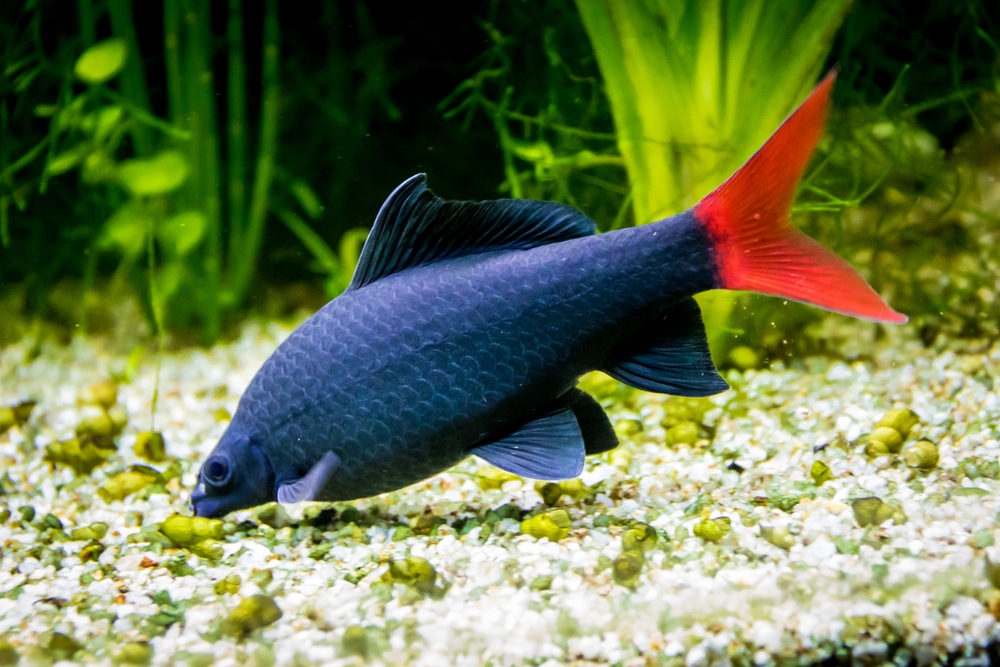
The Red Tail Black Shark is one of the more tragic tales in the aquarium world. A striking fresh water shark fish, it is almost extinct in the wild. Red tail sharks live in the Chao Phraya River. As Thailand modernizes and develops, its habitat has disappeared as dams have been built and swamps have been drained.
Wild specimens have not been seen since 2011 and it may even be extinct in nature. The species is captive bred in large numbers, however. One day red tail black sharks will be reintroduced into the wild.
Red Tail Black Sharks are sold as 2″ juvenile. As adults they keep their midnight black bodies and crimson red tails, with a small white spot at the tip of the dorsal fin. They also grow aggressive and territorial, and are most intolerant of their own kind.
While they lack sizable teeth they will bite the fins and flanks of slow moving fish that live in the same area of the tank. The behavior is usually more of a problem in smaller aquariums.
When given at least 55 gallons of space or more, adult Red Tailed Black Sharks are good additions for a semi-aggressive community tank. Providing a cave or nook of driftwood gives the Shark a focal point to defend, allowing its tank mates to swim in peace.
As true omnivores Red Tail Black Sharks will eat anything you offer them. In the wild, detritus, bottom dwelling invertebrates, and even algae is eaten. In a shark fish tank they will take flakes and other prepared foods. They also eat filamentous green algae, blanched vegetables, and frozen foods.
- Scientific Name: Epalzeorhynchos bicolor
- Origin: Thailand
- Length: Up to 6″
- Aquarium Size: 30+ Gallons
- Temperament: Semi-Aggressive
Rainbow Shark
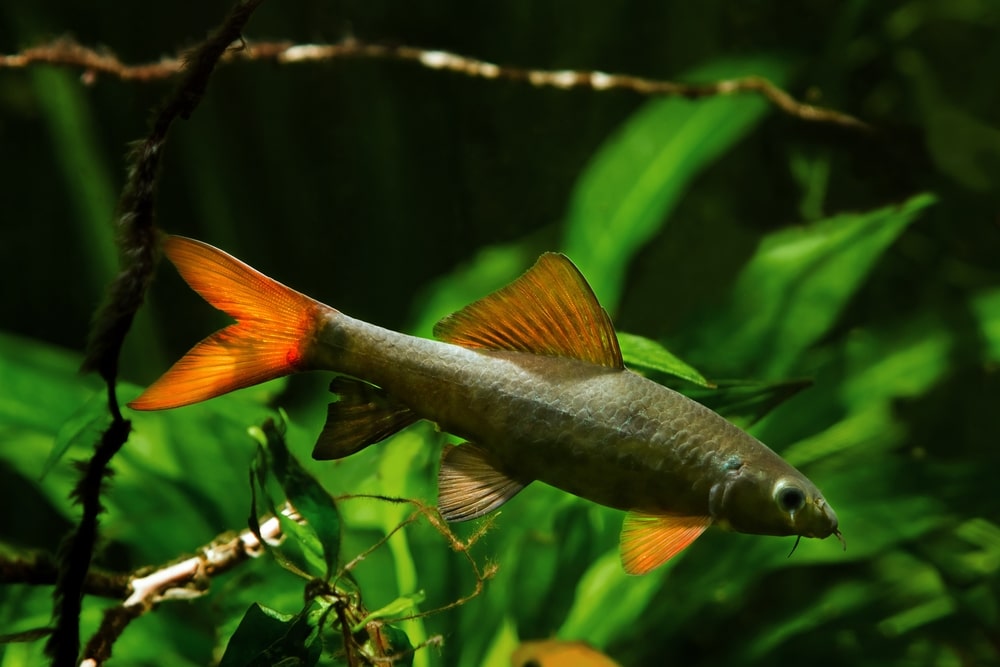
As a close relative of the Red Tail Black Shark, the Rainbow Shark is similar in color. All of its fins are pink to red with a gray body that can be almost black but never as dark as its close cousin. Albino Rainbow Sharks are more common in the trade and less expensive.
Rainbow Sharks have identical care requirements as well. As bottom dwelling omnivores they will take any prepared or frozen foods offered.
They share the same semi-aggressive attitude and will bully slow moving mid and bottom dwelling fish if they stray into its territory. A cave or hollow to claim will help mitigate some of their outward aggression.
Rainbow Sharks are also intolerant of other Sharks, including other Rainbows, unless kept in large aquariums with plenty of hiding spaces.
The tank should have 3 or more Rainbow Sharks to diffuse aggression across the group. When kept with Red Tail Black Sharks Rainbows tend to lose as they are thinner and weaker fighters.
- Scientific Name: Epalzeorhynchos frenatum
- Origin: Southeast Asia
- Length: Up to 6″
- Aquarium Size: 30+ Gallons
- Temperament: Semi-Aggressive
Black Shark Minnow
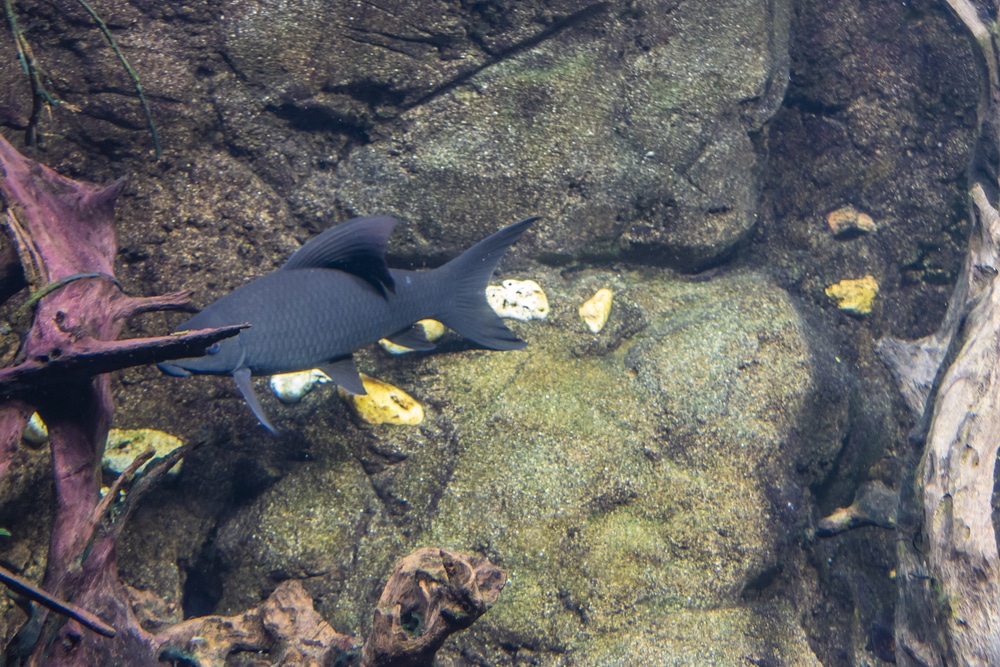
When young it’s obvious that the Black Shark Minnow is a close relative of the first two Shark species. The Black aquarium shark fish grows massive in comparison.
24 inches is normal for aquarium specimens and up to 36 inches in nature. Black Sharks are common and desirable enough to be sought by fisherman for sport as well as food.
Black Sharks are not popular in the pet trade but are sometimes sold to aquarists who don’t realize that they will outgrow all but the largest of aquariums. Adult Black Sharks have flowing fin extensions and a purplish black color that’s striking. They are robust fish that can weigh as much as 25 lbs.
Like their smaller cousins, Black Shark Minnows are Cyprinids, in the Carp family. That makes them related to Goldfish, Koi, Barbs, and Danios. Cyprinids as a whole tend to be bottom dwelling omnivores that are hardy aquarium fish.
Given the size and territorial nature of the Black Shark it’s essential to pair them with large fish fast enough to get out of the way. And to provide them with ample space for them to claim an area.
- Scientific Name: Labeo chrysophekadion
- Origin: Southeast Asia
- Length: Up to 3 feet
- Aquarium Size: 180+ Gallons
- Temperament: Semi-Aggressive
Bala Shark
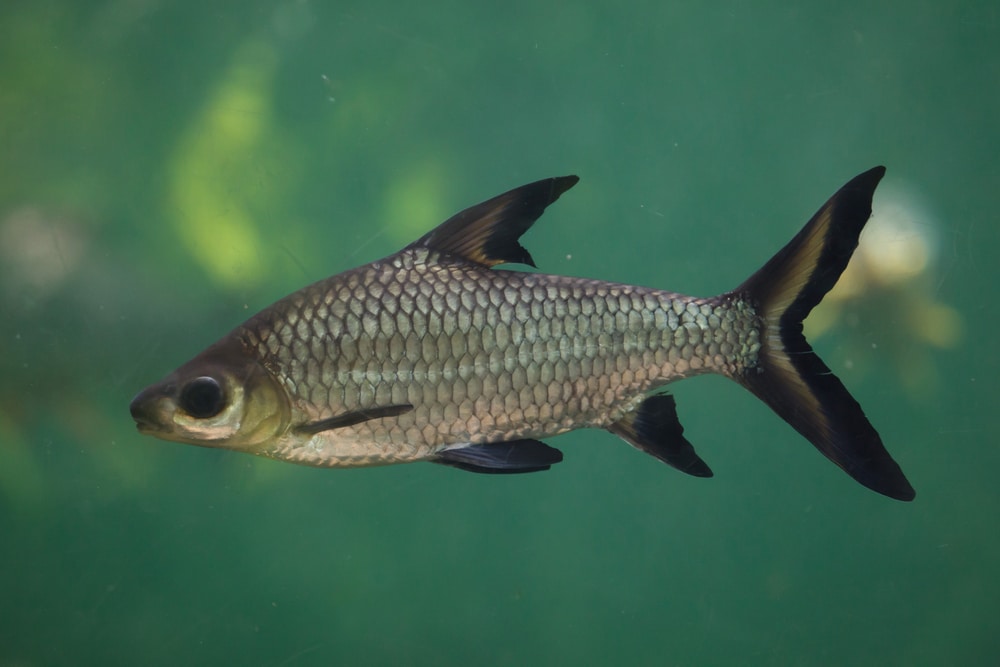
Bala Sharks are very common in the aquarium trade, which is not a good thing. They are sold as small, pretty fish with tinfoil bright scales and contrasting black edges to their fins. Their triangular fins look more like true marine sharks than any of the other “sharks” on this list.
While they retain this look as they mature they also grow too large for most aquariums. Bala Sharks that have outgrown their tanks are also common for pet stores to receive. So don’t count on a store taking your fish shark once it’s grown up.
Adult Bala Sharks are over a foot long and at all ages are schooling fish. When kept alone, Bala Sharks are nervous fish that will launch themselves against the glass or lid if the tank is too tight. When kept in schools of 6 or more Bala Sharks are less skittish but still grow large and need lots of space.
125 Gallons is the absolute minimum for a school of Bala Sharks, with larger being better. A heavy, well fitting lid is essential as they will test it on occasion when scared. If the lid isn’t strong enough your shark fish pet might end up on the floor.
Bala Sharks are peaceful midwater dwellers and are an active addition to any community tank of medium to large fish. In the wild Bala Sharks eat plankton and small floating invertebrates. In aquariums they will take both prepared and frozen foods with gusto.
- Scientific Name: Balantiocheilos melanopterus
- Origin: Malay Peninsula and Indonesia
- Length: Up to 14″
- Aquarium Size: 125+ Gallons
- Temperament: Peaceful
Iridescent Shark
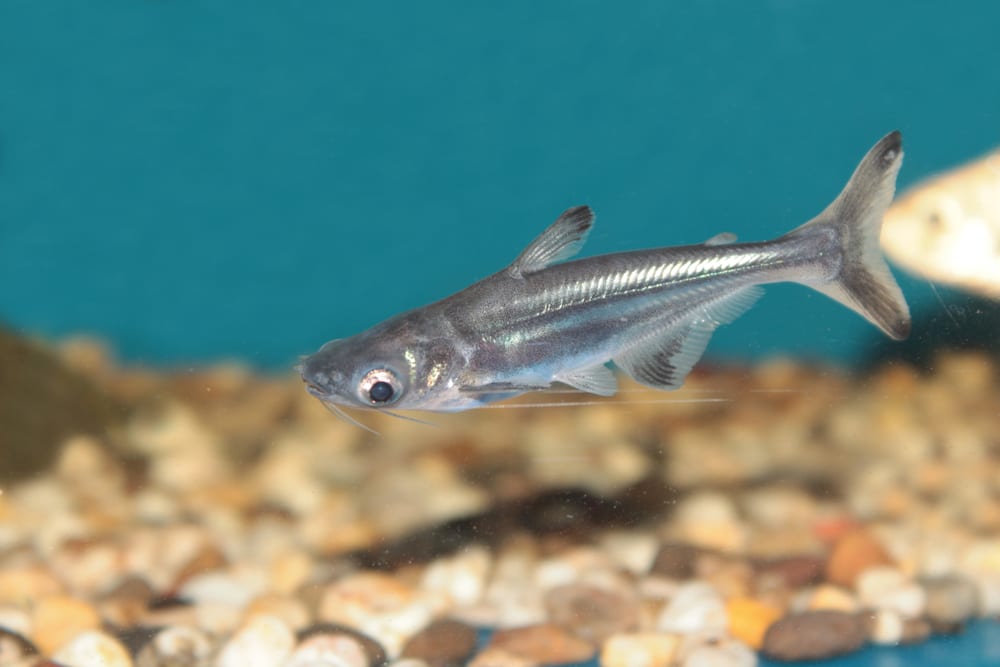
The Iridescent Shark is another inexpensive aquarium fish that is unsuitable for the majority of aquariums. They are active and beautiful, with a purplish black shine to them. Iridescent Sharks will reach 3 to 4 feet in length and worse, they are schooling fish.
Iridescent Sharks are related to the Mekong Giant Catfish (Pangasianodon gigas), which grows up to 10 feet long and is one of the largest freshwater fish in the world.
Iridescent Sharks are midwater dwellers that swim fast and aren’t shy about finding food at the surface. They are peaceful community fish but will consume tank mates small enough to fit into their broad mouths.
So long as you have the space for them Iridescent Sharks are good additions to a freshwater shark community tank.
As large, schooling fish that are easy to feed and grow fast, Iridescent Sharks are a popular food fish in Asia. You also might have come across Iridescent Sharks in the frozen seafood section of your local grocery store.
In Western countries they are sold under the name Swai. Firm and delicate in flavor, it can be used as a replacement in any recipe calling for freshwater whitefish.
- Scientific Name: Pangasionodon hypophthalmus
- Origin: Southeast Asia
- Length: 36-48″
- Aquarium Size: 300+ gallons
- Temperament: Peaceful
Chinese High-Fin Banded Shark
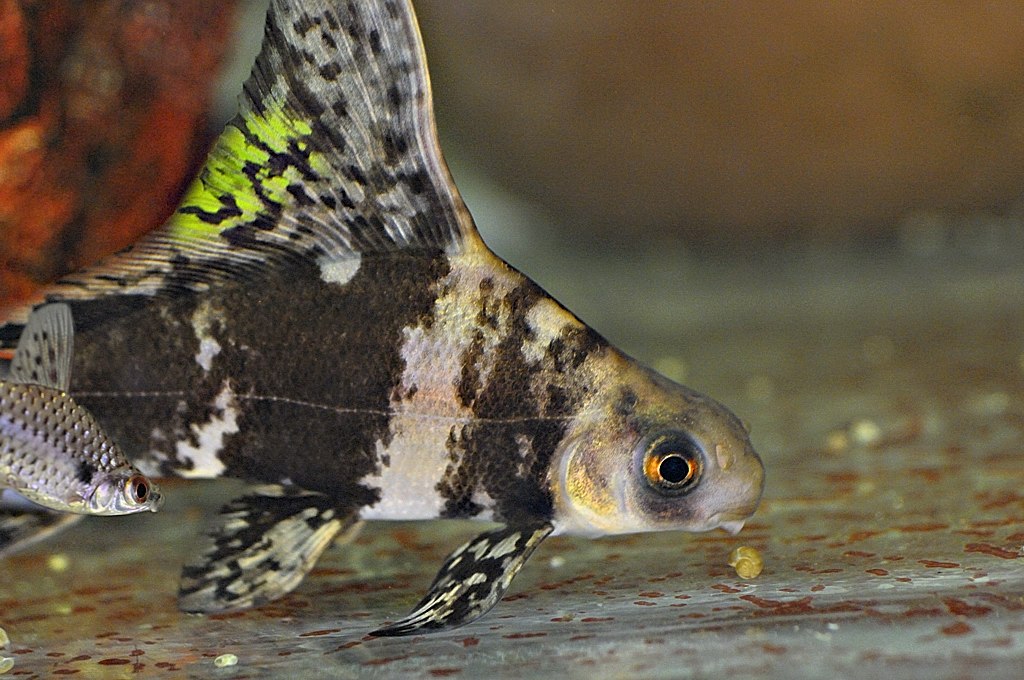
The Chinese High-Fin Banded Shark is a large cyprinid that undergoes a reverse Ugly Duckling transformation.
When young it’s beautiful, with chocolate brown to black bands and mottled patterns on a peach colored background. The sail-like dorsal fin sits high on an arched back and they are peaceful community dwellers with an active personality.
As adults, they are a mud brown, cigar shaped fish with a sucking mouth similar to Chinese Algae Eaters. The entire transformation takes place over the course of two years. They consume algae, detritus, and other organic matter from rocks in fast flowing rivers and streams.
In the wild these shark fish grow up to 5 feet long and weigh up to 80 lbs. Chinese High-Fin Sharks are also an endangered species in China. The few that make it into the trade are captive bred in Asian ponds.
One major reason most of these freshwater sharks die in captivity is because they aren’t tropical fish. Chinese High-Fin Sharks are cold water fish.
While they will tolerate temperatures up to 75F they prefer being kept in unheated aquariums and outdoor ponds.
They thrive alongside Goldfish and Koi and will keep pond decorations free of algae. Chinese sharks will also hibernate once the water reaches 40F.
- Scientific Name: Myxocyprinus asiaticus
- Origin: China
- Length: 4-5 feet
- Aquarium Size: 300+ Gallons
- Temperament: Peaceful
Columbian Shark
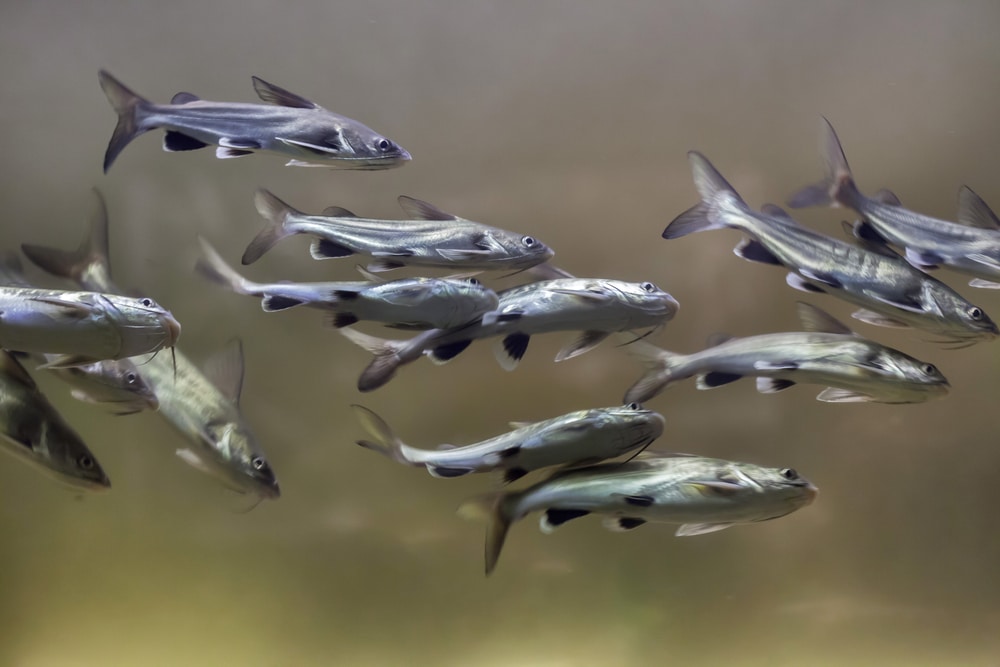
Also known as the Silver Tipped Shark, the Columbian Shark is a predatory Catfish with unusual care requirements.
Young aquarium shark fish are common in the pet trade. These silvery blue, active fish will eat anything you offer.
That also includes small, sleeping tank mates as they grow. Columbian Sharks are fast predators with large mouths.
While predatory, they are not aggressive towards other fish and prefer being kept in schools. Columbian Sharks grow to be a foot long and are skittish when kept alone. So a tight fitting lid is essential.
They are also not true freshwater shark fish. As they mature, Columbian Sharks need to be acclimated to either brackish or saltwater environments. Otherwise they will get sick and die.
Columbian Sharks, like many Catfish, have venomous spines along the pectoral and dorsal fins that they hold rigid when chased or netted.
The sting is not life threatening but is very painful. If stung, run the affected area under water as hot as you can stand to detoxify the venom.
- Scientific Name: Ariopsis seemanni
- Origin: Central and South America
- Length: 12″
- Aquarium Size: 75+ Gallons
- Temperament: Peaceful
Roseline Torpedo Shark
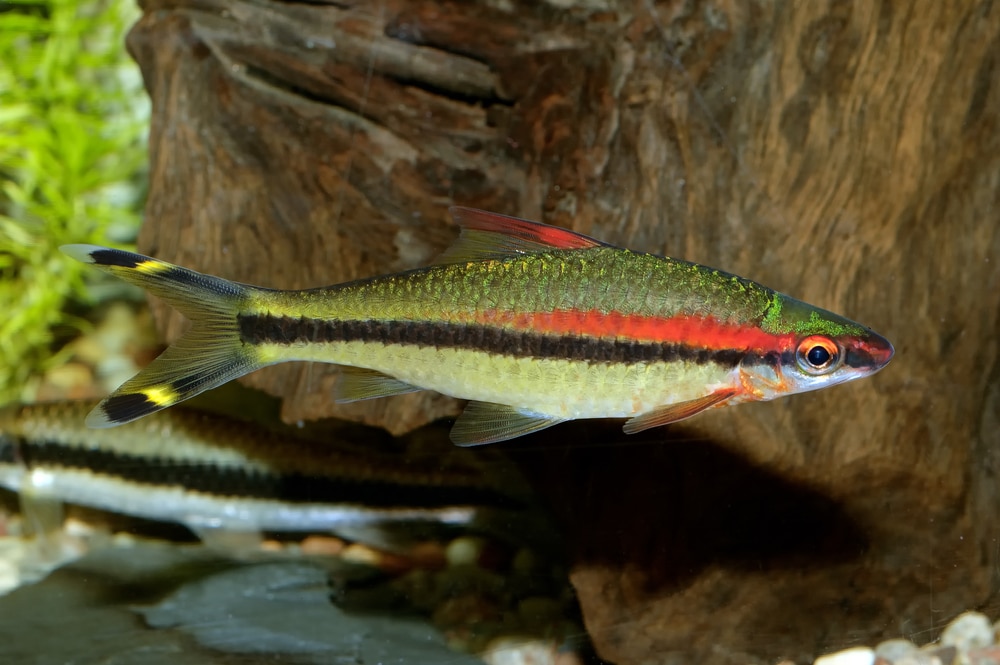
Also known as Denison’s Barb and the Roseline Shark. These freshwater aquarium Sharks are one of the few species suitable for the average aquarist. They are medium-sized schooling fish that grow 4 inches long in aquariums and a bit larger in nature.
Roseline sharks have vivid yellow and red lateral stripes matched by attractive patterns on their tails. They are becoming common in the trade but most Roseline Sharks are wild caught. Captive breeding efforts have not yet caught up to demand.
They are so popular that they are now an endangered species in their homeland. If possible, try to ensure that your Roseline Sharks are captive bred to prevent them from going extinct in the wild.
While a little pricey, they are schooling fish and should be kept in groups of at least 6 individuals. Roseline Sharks are not demanding when it comes to water quality or feeding. They thrive in a wide range of temperatures and accept both prepared and frozen foods.
- Scientific Name: Sahyadria denisonii
- Origin: India
- Length: 4-6″
- Aquarium Size: 30+ Gallons
- Temperament: Peaceful
Harlequin Shark
The Harlequin Shark is our last freshwater shark and resembles the Red Tail and Rainbow Sharks in terms of appearance and care requirements.
Harlequin Sharks are from Central Africa. They are a semi-aggressive omnivore that has a more cryptic coloring to blend into dappled sunlight and shadowy tangles of weeds.
Harlequin Sharks will eat anything offered, including algae, invertebrates, and both frozen and prepared foods.
Harlequin Sharks are territorial just like their cousins and need a cave or grotto to call their own. Otherwise they will claim the entire bottom zone as their own in smaller aquariums and bully their tank mates to death.
They will also fight if kept with their own kind, including the Asian freshwater shark fish.
- Scientific Name: Labeo cyclorhynchus
- Origin: Congo River Basin in Africa
- Length: Up to 6″
- Aquarium Size: 30+ Gallons
- Temperament: Semi-Aggressive
Freshwater aquarium sharks come in a variety of types. They aren’t related to marine sharks but many are difficult fish to care for because of the same reasons: shark fish tend to be aggressive and large. These fish are omnivores, however, and are hardy when provided with a large enough tank.
FAQs
Is Shark Fish Good for Aquarium?
Shark fish are good for aquariums that are 30 gallons in size or larger. Some species grow so large that they need 100 gallons of space or more, however.
Are Shark Fish Aggressive?
Shark fish tend to be aggressive. The Roseline Shark and Bala Shark are the two freshwater sharks on this list that are peaceful community fish.

